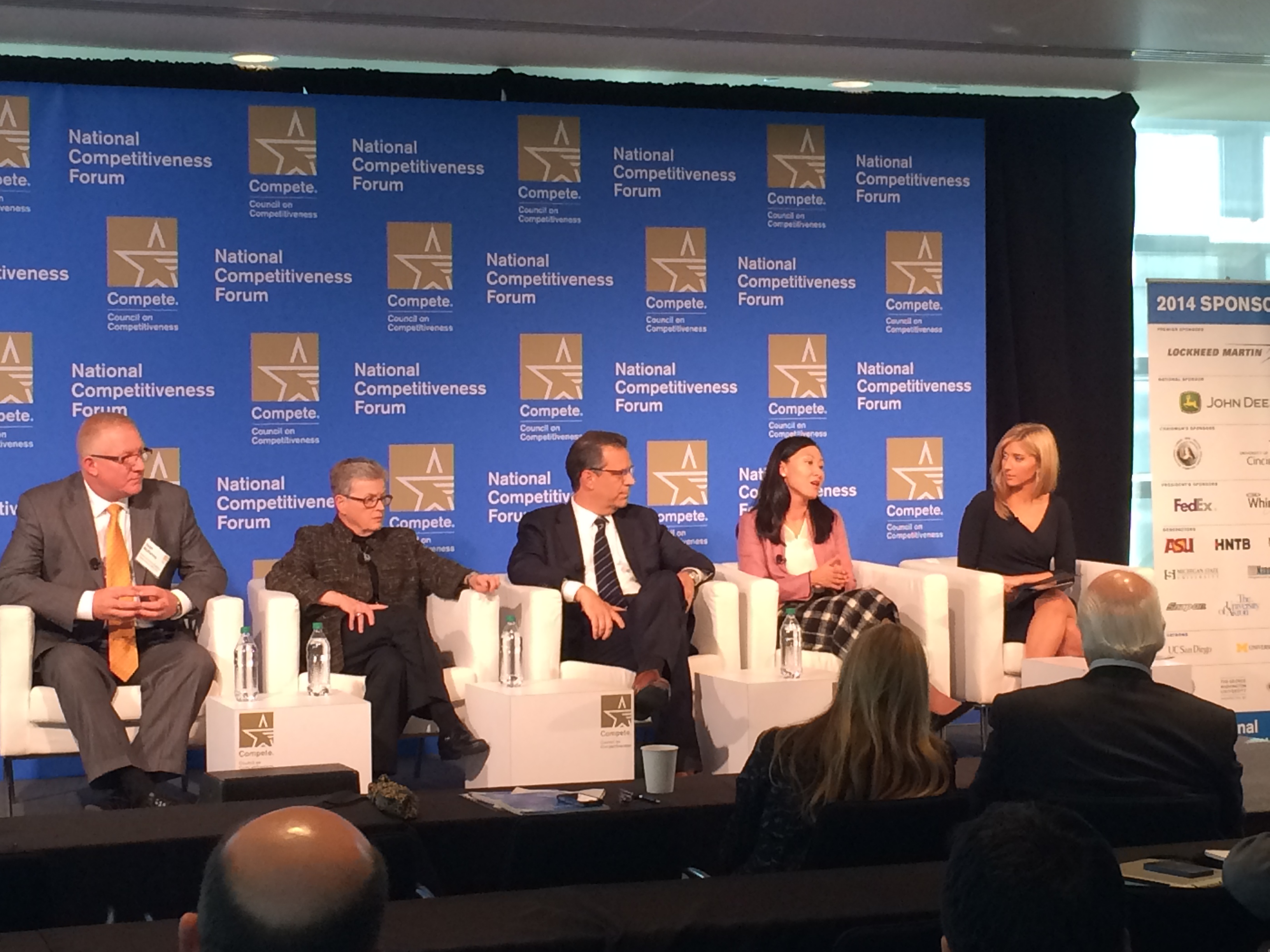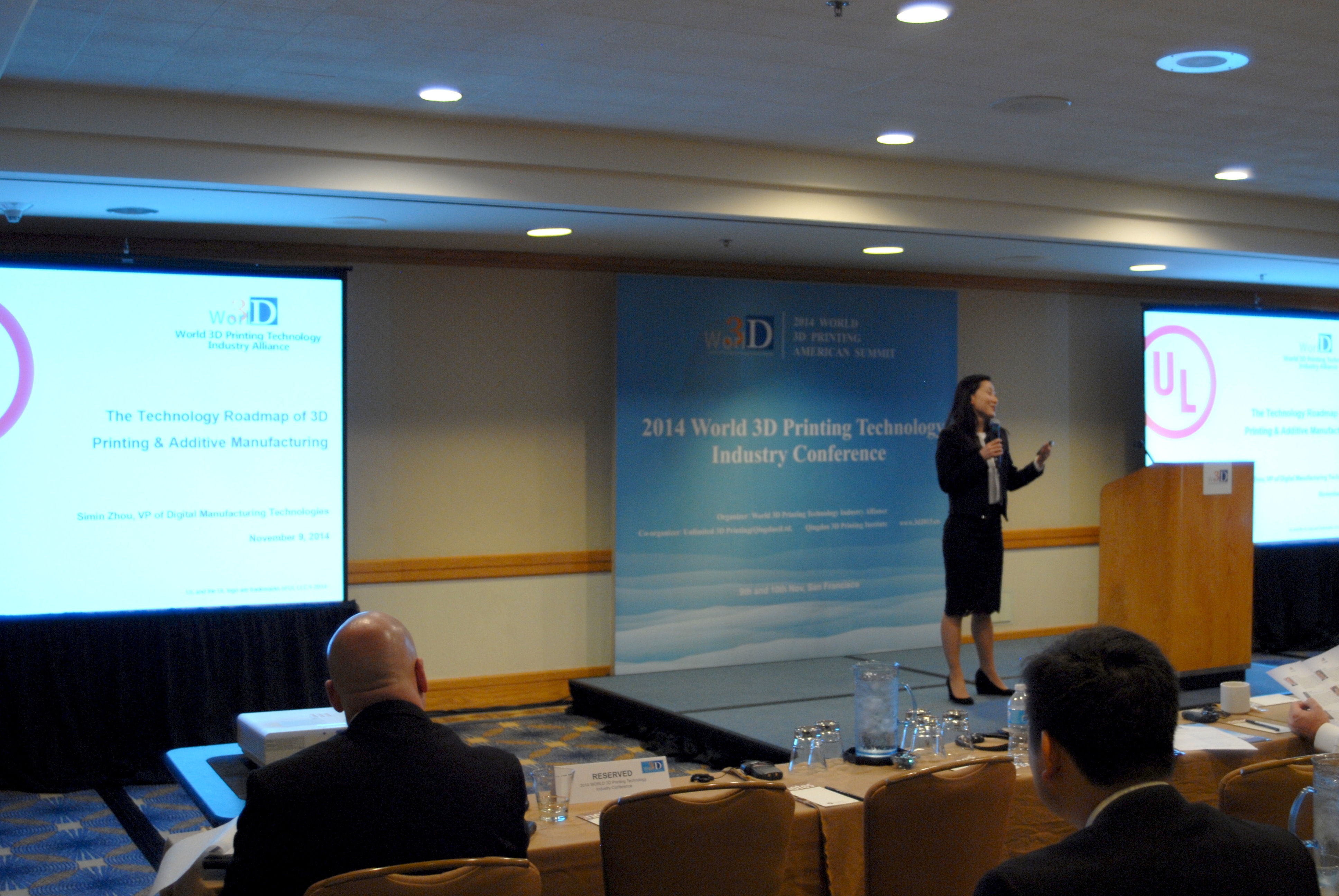At global safety sciences company UL, Simin Zhou leads Digital Manufacturing Technologies, with an emphasis on 3D printing & additive manufacturing. 3DPI’s Andrew Wheeler spoke with her about her work in 3D printing & additive manufacturing, which focuses on providing widely available training & education, as well as simplifying and improving compliance of equipment and materials, and developing infrastructure to support quality and safety of 3D printed parts and products. Simin serves on the Governance Board of America Makes (the National Additive Manufacturing Innovation Institute), and Advisory Board of the Milwaukee School of Engineering Rapid Prototyping (Additive Manufacturing) Center.
3D Printing Industry: Could you briefly go into a summary of what UL has done with 3D printing or what’s going on in terms of general operations? Is there anything there already, or are you building it from the ground up?
Simin Zhou: UL’s primary focus is around safety and quality assurance in additive manufacturing, and we are addressing major initiative areas, including research for standards and regulations and training and education.
With research, UL is looking to better understand the science behind 3D printing to inform what needs to go into standards and what needs to go into various regulatory aspects. So, we are looking at key areas, including materials, processing, and emissions. Our goal in any new area is to try to understand the science behind what is happening. So, this is one key area of effort for us, and we have been at it for about a year.
The next major area for UL surrounds training and education. It is a really important issue in this industry because it is moving so fast, the technology is so diverse and applicable across many different applications and industries. In order to do this effectively, UL developed a training curriculum that addresses the foundations of 3D printing, economics of 3D printing, and key technical areas of 3D printing. Last year, we finished building the foundations and you can actually take our course online or attend an in-person training session. We offer both options so professionals can interact one-on-one with an expert in the industry, and access the information remotely. You may find more details at ul.com/3Dprinting. What it does for the additive manufacturing industry is provide a baseline training that is technically accurate and third-party reviewed in a comprehensive way.

3D Printing Industry: There are many interesting problems with 3D printing. What is UL doing about the quality assurance of industrial 3D prints? What kind of things are you researching in terms of quality assurance with industrial 3D printing?
Simin Zhou: Well, another one of our initiatives is actually around how to validate 3D printed parts and products. The key to that is understanding the material, understanding the processing conditions behind it, and what actually happens during the process. There is no one way to do that in additive manufacturing, so UL looks at how to put in the control point to ensure professionals have considered both the proper quality and safety aspects. This is what we took into consideration when we developed our Q&A framework. The framework provides a step-by-step process to address the entire evaluation method and better understand how current regulations are included in that process.
For example, if you were developing a toy, there are very specific requirements and regulations that vary in the U.S. by state, and, internationally, it varies by country. What are the chemical requirements? What are the actual specific product regulations? By addressing questions such as these, we would be able to fully understand what materials, what shapes and other considerations are involved. UL would then conduct the proper design validation, address the regulatory understanding and then create a program to make sure they have the proper controls to meet the design and production.
3D Printing Industry: So, you are acting as a sort of consultant for people who are interested in using additive manufacturing to create toys, for example, and if they are, say, in New Jersey, they can consult you and you will come up with a guideline? Is that correct?
Simin Zhou: Absolutely! We provide advisory services and validation testing inspection for manufacturers and designers to make sure everything is in order. For additive manufacturing, UL has taken the time to build our knowledge around the materials, the process, and the control point — that is where the research really went, to understand everything involved in more depth.
3D Printing Industry: Toys just one industry, though. Are you working with more advanced manufacturing for aerospace, automotive, or other industries?
Simin Zhou: UL has worked with many other industries including medical, industrial, and more. This field is so broad and that is why the technology is great because it allows us to bring new concepts to a very broad range of companies and clients.

3D Printing Industry: What would you say is the most difficult obstacle in terms of regulating 3D printing around quality assurance?
Simin Zhou: UL receives this question a lot. First of all, how you produce a product is only one aspect of quality assurance. There are product regulations, standards, and requirements in place and that should not change depending on how you are producing it. So, I always tell people, product regulations are product regulations. They already exist. There are good standards in place and a good understanding of what they are. So, in general, 3D printing is another technology that enables people to produce the products that apply to those regulations. That is not a game changer. UL can help people understand that and demonstrate how to make it work.
Where it becomes more difficult is the fact that manufacturing products can become so personalized and customized. Now you are talking about one-off products. How do you scale from a quality and safety perspective when you are dealing with a totally different level of customization? That is where a lot of work is needed to understand and build the long-term infrastructure.
3D Printing Industry: So, have you worked with any big companies along the supply chain of low-volume, highly customizable parts?
Simin Zhou: Yes. UL has worked with a variety of different clients and industries. The companies we see who are producing the one-off products today are really in the medical and consumer product space. In the medical space, everyone is interested in learning more about customized products for patients and trying to understand how this is going to work. Whereas, in the consumer product space, the products you are looking at today are pretty low risk. So, the question is: how do we produce these higher risk products and understand their effects?
3D Printing Industry: Do you have any thoughts on or have you explored digital rights management such as different CAD designs? Have you addressed this type of concern more from the CAD model side, and the reverse engineering by scanning?
Simin Zhou: We’ve looked at it, but we haven’t addressed it yet. I don’t believe there is a point solution for something like that. First of all, the technology is not nearly as easy as people want to make it out to be. Over time, I think it will get easier, but, to produce truly quality parts, it takes a lot of effort. So, to suggest that we will move from such a high-rigor control environment that is well-managed to one in which anybody can print anything, I think that is still a long way off. We need to look at what are the check points that we can build between now and then to ensure that the proper infrastructure is in place?
3D Printing Industry: It is interesting because what is happening in the 3D printing hobby zone is that they are thinking of reality capture devices in a similar way to a camera and they are equating an object with a photograph. What are your thoughts on this market?
Simin Zhou: I think that, in addition to 3D printing, a lot of the innovation is coming from scanning technology. The next generation of phones are going to have 3D sensors on them. The issues that were difficult before, will then be easier. With that said, we have gone through multiple technology waves. The computer wave is basically in our generation, as well as the Internet. So, it is basically a continual evolution, and we, along with many companies, will have to learn and evolve with where the market wants to go.
3D Printing Industry: Exactly! So, is UL attending any upcoming 3D printing events?
Simin Zhou: UL is going to be at AMUG and RAPID this year. At AMUG, we’re focused on spreading the word about education and training in additive manufacturing. Our lead 3D Printing Development Engineer, Paul Bates, is the education chair for the conference. For RAPID, UL will be presenting three areas that we are working on, including training, how we are helping the equipment and material provider to simplify compliance, and some of our initial work on the quality assurance framework.
I believe it is going to be exciting ten years from now because of all the technology evolutions, and 3D printing being a catalyst, these discussions, our conferences and the technology we use is going to look totally different. I don’t think any of us knows what that will look like yet. We are all working hard to make sure that the different pieces are in place to provide the proper support. I am really impressed with all that is happening all over the world. There is a really great energy about it.
3D Printing Industry: You’re right, 3D printing is just another way of making something. Makes me glad UL is out there educating people. What is UL doing in terms of the medical industry?
Simin Zhou: To add to your point about 3D printing just being another way to make something, if I am going to have 100% control over the materials, then I have almost no issues. Between trial and error, I can get there. What we really need to do is understand how to vary that. How do I get the efficiency and the cost effectiveness? That is where the big challenges come in.
The medical field is a perfect example of this challenge. If I wanted to customize every single product, I want to customize it to the patient and print it onsite at the hospital. Now, we have a problem. How do you assure that the digital file and product actually capture the right amount of quality and safety?
How do you assure the translation was done correctly? How do you assure the hospital staff was well trained and certified to do what it needed to do? That is where all the real challenges start emerging, and people and companies like UL have a lot of work to do to educate them. How do we assure that the infrastructure is in place to support that vision? In my mind, where there is a will, there is a way, and there are solutions we can work on. But, for UL, our approach is to collaborate with industry, academia, and government, and tackle these problems.
3D Printing Industry: What does UL bring to the future of 3D technology?
Simin Zhou: One of the big questions that our team is talking about is: how do you do design validation and software validation in an effective way? We have been looking at simulations and how to set up guidelines. There are a lot of issues and considerations that needs to get worked through, and it is a great opportunity for all of us to push the boundaries and just think about problems differently. We are excited to partner with industry, academia, and government, and advance the thought process in regards to quality. I think by partnering and collaborating, we will figure everything out.



